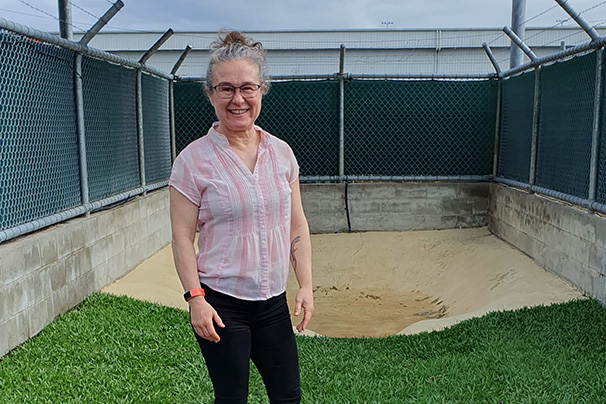University of Canberra Ecology Geneticists Develop eDNA Test to Enhance Safety in Croc Country
Researchers from the University of Canberra’s EcoDNA team have developed a genetic test to detect saltwater crocodiles in waterways using environmental DNA (eDNA) techniques. Currently undergoing field trials, the test could be used to monitor saltwater crocodile populations in the future and even help prevent crocodile encounters.
Saltwater or estuarine crocodiles live in waterways throughout northern Australia (known colloquially as Croc Country, due to the animals’ prevalence). While they play a vital role in the ecosystem, saltwater crocodiles can pose a significant threat to human safety.
Conventional tools to detect the presence of saltwater crocodiles often rely on land or vessel-based visual searches, but these are not always able to confirm the presence of these elusive animals.
In the search for a better monitoring tool, Dr Elise Furlan, a Senior Research Fellow with the EcoDNA team, is leading a research project funded by the Queensland Government to detect saltwater crocodile DNA in waterways.
The techniques used for eDNA detection target the DNA shed by organisms from skin, urine or faeces into their environment. Leaders in eDNA research, the EcoDNA team is recognised as the National eDNA Reference Centre, and recently received accreditation from the National Association of Testing Authorities (NATA).
“Testing for eDNA has been used across a broad range of species, such as fish, turtles and frogs,” said Dr Peta Hill, a Postdoctoral Fellow at EcoDNA, who joined the project in 2023. This eDNA test has been designed to identify saltwater crocodiles throughout Queensland, the Northern Territory and Western Australia, which means it can be applied to detect crocodiles across the entire Australian range.
The crocodile eDNA test was designed by Dr Furlan and is based on a Polymerase Chain Reaction (PCR) assay technique that ‘amplifies’ segments of DNA in environmental samples.
“It’s specific to saltwater crocodiles, and it can detect very low concentrations of DNA in the water,” said Dr Hill. The test is also adept at distinguishing saltwater crocodile DNA from its freshwater counterpart – freshwater crocodiles are generally shy animals.
The University is collaborating with wildlife officers from the Department of Environment, Science and Innovation (DESI) to assess the test’s effectiveness at detecting saltwater crocodiles in waterways around Croc Country.
Dr Hill and her colleagues first tested the eDNA assay on synthetic DNA and saltwater crocodile tissue samples. The next step was to see whether they could detect saltwater crocodile DNA using water samples from Hartley’s, a crocodile tourist park in Cairns.
“There could be all sorts of DNA in there – from humans, algae, turtles, freshwater crocodiles –everything that lives in the water,” said Dr Hill. “This assay was successful in picking out the saltwater crocodile DNA for those samples as well.”
The researchers travelled to Cairns in early July to carry out captive trials in crocodile holding ponds at a DESI facility. The trials were designed to identify how soon crocodile DNA can be detected after a crocodile enters the water.
Water samples were taken before and after placing a saltwater crocodile in a holding pond, and sampling continued after the animal was removed, to see how DNA degradation affected the tests.
“Knowing how long DNA persists in the waterway will be really helpful to determine how recently a crocodile may have been in the area,” said Dr Hill.
The next stage of testing the eDNA assay will be carried out by DESI Wildlife Officers throughout northern Queensland. This will involve eDNA surveys in natural waterways with known presence of saltwater crocodiles, and will include a variety of water bodies, from dams to large saltwater river systems.
“We’ll start to get a feel for how well the test works in the field depending on animal densities,” said Dr Hill. “Factors like water flow rate, rainfall, temperature and salinity may also play into whether or not we can detect eDNA from a particular water body.”
In the future, the eDNA tools could be used to equip rangers with portable test kits – imagine rapid antigen tests (RATs) for saltwater crocodile detection. The ideal device would be able to detect crocodiles within hours of dip-testing a water body.
“That kind of test as an ultimate endpoint would be fantastic,” said Dr Hill, who notes that it would likely only be available for qualified wildlife officers to use.
“It would be a wonderful addition to the monitoring and management actions currently undertaken by DESI.”
While ‘crocodile RATs’ are a number of years away, the eDNA assay will be a helpful tool for identifying saltwater crocodile habitats.
“As human populations expand and croc populations continue to recover in numbers, there’s going to be more overlap in terms of interaction,” said Dr Hill.
“This project is really useful from a human-wildlife conflict perspective, but also understanding saltwater crocodile ecology. Understanding the movements and usage patterns of waterways of the animals will be very helpful.”

